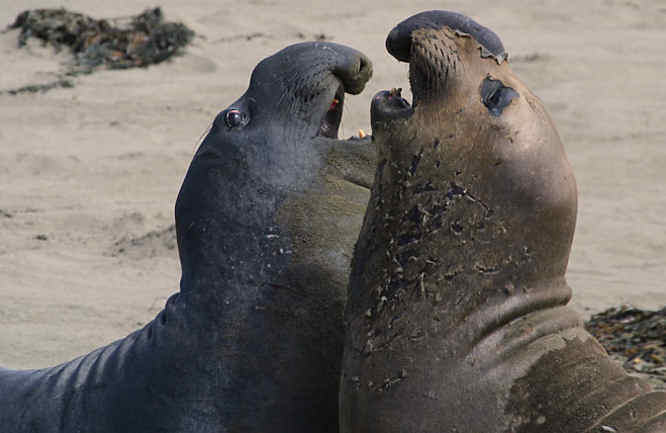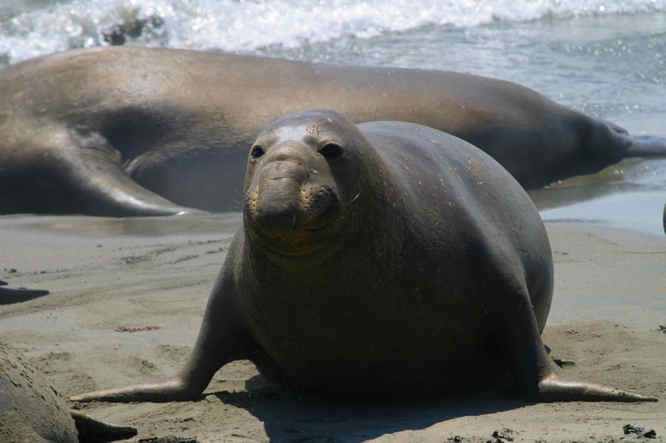Big Sur Beach Elephant Seals (Dec-Feb)
Big Sur Valley is located 146 miles South of San Francisco on the famous California coast road route one. If you are visiting San Francisco during December, January or February seriously consider renting a car and driving to the Beaches of the Big Sur area. It will take about 2 hours 30 minutes and will be worth the effort. The beaches are beautiful as is the pacific costal drive.

What you are driving to see is one of nature's rare wonderful sites. Huge Elephant seals have chosen these beaches to breed, give birth and moult. If like me, you love seeing wildlife in its natural environment, the sight of hundreds of over sized seals with wobbly big noses making strange noises is not one to miss.
Big Sur is not one single location. It is a 50 mile stretch of Californian Coast with some of the best seascape views on the continent of North America. There are a number of State Parks along the coast. The beaches they have chosen to colonize are in the southern range of Big Sur, near San Simeon.
Elephant seals have been hunted nearly to extinction for their oil-rich blubber. They have started to make a remarkable comeback. Legislation now protects these endangered aquatic mammals in the form of the Marine Mammal Protection Act. The oil harvested by shore whalers and sealers from slaughtered elephant seals is second in quality only to the sperm whale.

By the beginning of the 1900's it was thought they were extinct. On Guadalupe Island, off Baja California, a small group of between 20-100 elephant seals survived the seal hunts. Mexico and later the United States Governments issued laws to protect them. Over the next 100 years the population increased from 100 to around 150,000 in 2000.
In November mature bulls begin to arrive. They start to fight to determine the pecking order. The most dominate males will mate with the most females who start arriving in the middle of December. They carry on arriving until the middle of February. The first pup is born around Christmas. The biggest number of births usually occurs during the last two weeks of January. Female elephant seals will remain on the beach for about five weeks but the males are on the beach for around 14 weeks. They do not eat while they are on land and will lose about 1/3 of their body weight during the breeding season.
If you see two of the large male bull sea elephants rearing up on their hindquarters, throwing back their heads, bellowing threats and showing off the size of their noses battle is about to start. The winner can then form a harem of females and breed with them. Fights between males can be bloody affairs but rarely end in death. The males are not the only noisy ones on the beach. The female elephant seals squabble, grunt, snort, gargle and belch with each other over the best parts of the beach and the pups squawk to be fed.
Within 4-5 days of the female's arrival on the beach the pups are born. They suckle for 24-28 days. When the pups are weaned the mother abruptly departs for the sea to hunt for food. The abandoned pups remain at the rookery, teaching themselves how to swim, before taking off on their first foraging trip, for 8 to 10 weeks. Mating occurs during the last 3-5 days of nursing. The peak of mating activity is around Valentine's Day.
DANGER: Elephant seals are wild animals and can kill or injure humans if they get too close. More importantly disturbance by humans may cause pups to be separated from their mothers, often leading to their death. 50 to 100 feet is a safe viewing distance. Use good binoculars and a camera with a good long lens. If seals are looking at you, you may be too close for safety! Be prepared to run away.
Colonization of the Californian coast by elephant seals is a very recent phenomenon. In 1990 two dozen elephant seals were potted in the small cove just south of the Piedras Blancas lighthouse. The next year the number had increased to 400 seals. The first pup birth occurred in 1992. 50 pups were born in 1993. In 1995, 600 pups were born. Almost 1000 pups were born in1996. The colony now stretched all the way to the beaches that run along the Coast Highway.
Travel books

